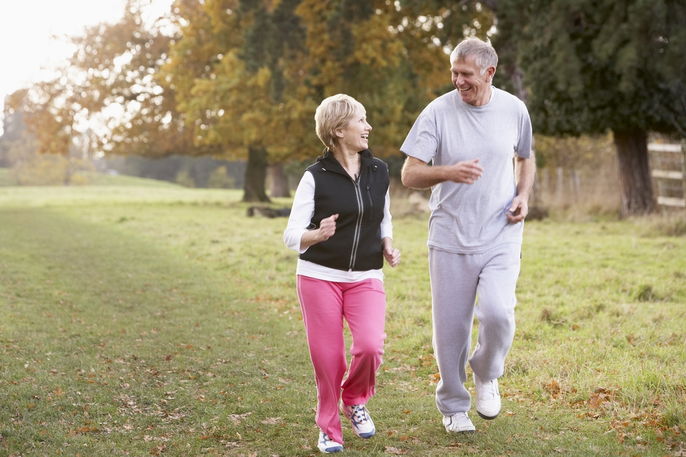Exercise for seniors is very important for maintaining good overall health, helping to preserve or increase muscle mass in addition to conserving bone density; improving balance, coordination, and mobility; reducing the risk of falls; and helping maintain independence in performing daily activities.
It is important to talk to your doctor or primary care provider before starting an exercise program. Certain exercises may need to be adapted for people with conditions like cardiovascular disease or lung disease. In addition, it is important to stretch before and after exercising in order to prevent injury.

Exercises that may be recommended for seniors include:
1. Walking
Walking strengthens the muscles and joints and improves heart rate, in addition to promoting social interaction. While walking, it is important to keep your back and shoulders straight and maintain the same pace, which should be slightly faster than your typical pace. Make sure to wear comfortable walking shoes with good support and cushioning.
It is recommended to begin with short walks and increase the distance over time until you are walking 30 to 60 minutes, about three times a week. It is also important to stretch before and after your walk to avoid injury.
In addition, try keeping your elbows flexed during your walk, as you would if you were running, to prevent circulation problems from keeping your arms down by your sides for a prolonged period of time. Another way to do this is to walk while squeezing a ball to promote blood flow.
Read more about the benefits of walking.
2. Water aerobics
Water aerobics targets all the muscles in the body while promoting relaxation of the joints, helping alleviate pain while increasing muscle strength and resistance. Water aerobics also improves heart rate and lung capacity.
3. Swimming
Swimming is a very beneficial exercise for seniors because it is helps elongate and strengthen the muscles and joints in the body without the risk for injury. Swimming is a low-impact exercise, meaning it does not put a great deal of stress on the joints, which can be a concern at this age.
Swimming also helps relieve arthritis pain, prevent bone loss, and lower the risk of developing diabetes and hypertension (high blood pressure).
4. Squats
To perform a squat, start with your feet slightly farther than shoulder-width apart. Extend your arms out in front of you and parallel to the ground. Slowly bend your knees and push your hips back, as if you were going to sit down in an imaginary chair. Make sure to keep your back straight throughout the exercise. Return to the starting position and repeat the move 10 times.
It is very important that your knees do not track over your feet during this exercise. To avoid this, make sure you are pushing your hips back as far as possible. If you are not able to squat down very far, start by lowering as far down as possible and work to get lower over time.
5. Seated bicep curls
Start by sitting on an exercise ball or a chair without arms, holding one dumbbell in each hand with your palms facing out. Bend your elbows and slowly lift the weights up toward your shoulders, keeping your upper arms and elbows close to your body, then slowly lower the weights back to the staring position. Repeat this move 10 times.
This exercise helps build muscle strength and resistance, while also improving posture and increasing bone density, helping protect against wear and tear that can increase the risk for fracture.
6. Seated dumbbell press
Start by sitting on an exercise ball or a chair without arms, holding one dumbbell in each hand. Position the weights at the level of your shoulders, with elbows bent and palms facing out. Slowly press the weights up overhead until your arms are fully extended with a slight bend in the elbows. Return slowly to the starting position. Repeat this move 10 times.
7. Cycling
Cycling, or bike riding, is a great exercise for seniors because it helps strengthen the joints, especially the knees, ankles, and hips, in addition to strengthening the muscles of the legs and abs.
Riding a bike also helps decrease blood pressure and relieve pain caused by arthritis.
8. Pilates
Pilates helps stimulate blood flow and increase flexibility, strength, and coordination. In addition, it also helps improve posture and alleviate stress.
Check out other exercises to improve posture.
9. Stretching
Stretching, in addition to improving flexibility and blood flow, improves range of motion and helps with activities of daily living like picking up around the house and cooking, for example.
Stretching exercises also help decrease joint and muscle stiffness and prevent injury.
10. Knee to chest
Start by lying face up on an exercise mat. Next, bend one leg and bring your knee to your chest, holding it in place with both hands for 5 to 10 seconds. Place that leg back on the floor and repeat on the other side. Do 10 reps on each side.
11. Step-ups
Place one foot on a step or stair and, pushing through that leg, lift the other foot off the ground and up onto the step before slowly lowering it back down to the floor. Repeat this move 10 times on each side.
12. Yoga
Yoga includes exercises for both strength and balance, helping to improve posture, stability, and flexibility, in addition to elongating and toning the muscles and relaxing the joints.
Practicing yoga also promotes relaxation, increasing a sense of well-being and readiness to perform your daily activities.
Also recommended: 7 Benefits of Yoga: Relieving Pain, Reducing Stress & More tuasaude.com/en/benefits-of-yoga





























